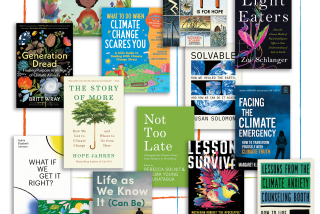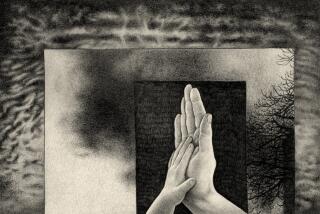Earth’s fragile dance
- Share via
IN the case of global warming, and the dangers it presents to wildlife, our water supply, the quality of our air and the safety of our homes, we have been given a mixed message. Environmentalists quote one set of scientists, who say it is happening and that it could produce ecological cataclysms that make New Orleans look like a tea party. The Bush administration prefers to call it “climate change” and clings to the idea that the rising temperatures of our seas and atmosphere are just trends. And if there is a problem with burning fossil fuel, it isn’t that the resulting carbon emissions may wreak an ecological disaster but that the fossil fuels may run out.
The author of the new book “Chasing Spring” climbs out of a hospital bed to set the record straight. He is Bruce Stutz, a former editor at Audubon and Natural History magazines. His story begins in November 2004, in a New York hospital, where the 54-year-old Stutz’s congenital heart defect is about to be fixed.
Stutz is worried about himself and us. No naturalist would miss the significance of illness in winter. One of the best-known effects of its cold, short days is the culling of the weak. Lying and waiting to have a tube threaded through his veins, Stutz readies himself for spring. Yet as he emerges into winter’s darkest days, he is a depressed paradox: healthy but emotionless. The heart is fixed, but he misses the old unruly flopping in his chest. There may also be a clinical complication: During surgery, a mechanical heart pump can feed impurities into the bloodstream, causing a sense of dullness that doctors call “pumphead.”
By January, Stutz is home in Brooklyn fretting. He reads that since 1950, the carbon-dioxide level in the atmosphere has increased faster than at any time in the last 20,000 years. All kinds of plants, from the cherry blossoms of Washington, D.C., to the morels carpeting Western forests, are emerging at least a week earlier than in the mid-1900s. Sea levels are rising. Can wildlife -- and humans -- keep up?
As if to give himself a jump-start, Stutz seizes on the season when the sap rises. He accepts the loan of an ’84 Chevy Impala from a friend and sets off across America -- following spring as it unfolds in the most temperate climates -- then heads straight to the Arctic. The farther north, the slower spring’s arrival. Timed right, he could ride a crescendo of new life.
In an admission that he himself is in a more autumnal phase, he sets some ground rules for chasing spring: “Always have enough gas. Let yourself be distracted. You’re never lost. Take one Eastwood [a siesta he’s named after action man Clint Eastwood] a day and one Jack Daniel’s each night.”
This is road trip as thesis, and Stutz stops in Durham, N.C., to see the experimental forest of William Schlesinger, dean of Duke University’s school of environmental and earth sciences. As CO2 emissions went unchecked for many years, a comforting notion had held that plants could simply absorb as much as we could put out, then lock it up in the ground. Schlesinger tested the idea by planting an experimental forest and flooding it with CO2.
The theory proved wrong, Schlesinger tells Stutz. The ground emits a certain amount of the carbon deposited by tree and plant roots. “At the present rate of CO2 increase,” calculates Schlesinger, “by 2050 the forests may be able to remove only 10 percent more carbon than they can now.” As CO2 levels rose in the Duke forest, trees slowly faltered but poison ivy thrived.
No Audubon editor would cross the United States without stopping at what is known as the Central Flyway along the Platte River in Nebraska. Half a million sandhill cranes, 90% of the bird’s population, stop here on their migration from wintering grounds in Mexico to nesting grounds near the Arctic. Snowmelt from the Rockies floods the plain, creating lakes where the birds feed, rest and build up the stamina needed for the journey to Canada, Alaska and Siberia.
“Cranes dance,” Stutz tells us. “Chicks dance. Adult mates dance. Courting pairs dance.” There is no better writing on nature than his account of cranes dancing in the Platte. However, anyone used to nature films knows that at some point, the antelope gets jumped by the lion. In this case, dams and drought are drying up the Platte and farmers are sucking up the groundwater. A crane sanctuary manager tells him the birds are in the worst physical shape observed in 30 years.
Global warming may sound like a way to save on heating bills, but wherever Stutz takes us, he shows how it is ruining ancient associations between flora and fauna. In the Sonoran Desert’s “nectar corridor,” birds and bats depend on the ocotillo flower, while the cactus depends on the wildlife for pollination. Yet warmer spring temperatures are forcing earlier blooms, before the animals begin their northward migration. “Imagine that the train you take to work begins to come earlier and earlier each day,” Stutz writes, “but your alarm continues to wake you at the same time each morning.”
A lesser diarist would keep battering us. But Stutz is not all coming cataclysm. In fact, he’s so human that you want to nag him. This environmentalist not only drives a gas-guzzler, he also orders steaks after heart surgery. He drinks strange herbaceous moonshine and accepts a cigarette from mushroom pickers. He climbs and climbs until he’s truly hurting. Not once does he admit it, but his heart is healing.
What never fails to endear this strange narrator to us -- and gives him a father-like quality -- is that he is an irrepressible geek. As he passes a reenactment of the Crucifixion in the Bible Belt, he describes its mythical antecedents. It’s a safe bet that nobody ever asked for the associations between Punxsutawney Phil and Candlemas, but Stutz works them in.
The trip, and spring, ends in June, in Alaska. After his plane sets down in the virgin snow of the Arctic National Wildlife Refuge, Stutz crawls through the mud to see caribou congregating. This is the season when more than a million of them migrate from the shelter of the Canadian tree line to calve in the Arctic tundra.
“They saunter in loose formation, large deer on gangly legs, many with fluff-tailed young -- no more than a couple weeks old -- scampering alongside, some trying to grab a teat and suckle on the run.” He has reached the spot the native Athabaskan Gwich’in call “the Sacred Place Where Life Begins.”
The spring journey of the caribou began about the same time as his, Stutz realizes, “and here is where both our journeys end.” *
More to Read
Sign up for our Book Club newsletter
Get the latest news, events and more from the Los Angeles Times Book Club, and help us get L.A. reading and talking.
You may occasionally receive promotional content from the Los Angeles Times.






